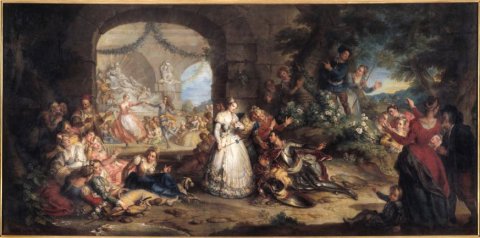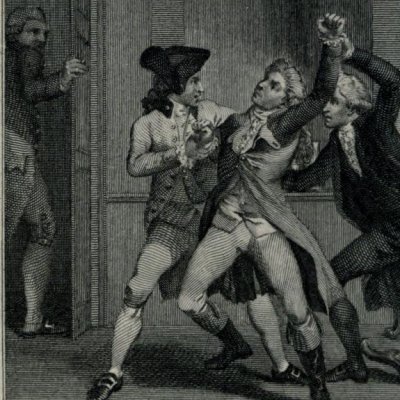
A visual clutch is usually a character in the foreground, at an angle or from behind, who is watching the scene. The visual clutch acts as a relay between the viewer (spectator of the painting, spectator at the theater, reader) and the scene itself (restricted space).
The need to place a visual clutch between the external spectator and the scene proper was already emphasized by Alberti in the De pictura: "Next, it is good that in a story there should be someone who warns the spectators of what is going on there; that with his hand he invites them to look, or, as if he wanted this affair to be secret, that with a threatening face or fierce eyes he forbids them to approach, or that he indicates to them that there is there a danger or something worthy of admiration, or that, with his gestures, he invites you to laugh or cry with the characters. " (II, 42, ed. Macula, p. 179.)

Lovelace's dedication to the announcement of Clarisse's death (illustration for Novelist's Magazine, 1784). The hat on the ground and the overturned chair signify Lovelace's outburst. But they also introduce an intermediate space between the viewer of the image and the scene itself. Oriented towards Lovelace, pointing at him, these inanimate objects act as visual clutches.
Sometimes the function of visual clutch is assumed by an inanimate object (a hat on the ground, for example) or a fabric element (balustrade, ledge, low wall). The visual clutch materializes the screen of representation: we don't look directly at the scene; we look at it through an obstacle that it helps us to cross. The visual clutch establishes an intermediate space between the stage proper and the outside, where the real spectator is: this space, which envelops the stage, generally extends into the background, highlighting the fact that the screen is merely the diminished, stylized form of the wave space.
Critique et théorie
Archive mise à jour depuis 2008
Critique et théorie
Généalogie médiévale des dispositifs
Entre économie et mimésis, l’allégorie du tabernacle
Trois gouttes de sang sur la neige
Iconologie de la fable mystique
La polémique comme monde
Construire Sénèque
Sémiologie classique
De la vie à l’instant
D'un long silence… Cicéron dans la querelle française des inversions (1667-1751)
La scène et le spectre
Dispositifs contemporains
Résistances de l’écran : Derrida avec Mallarmé
La Guerre des mondes, la rencontre impossible
Dispositifs de récit dans Angélique de Robbe-Grillet
Disposition des lieux, déconstruction des visibilités
Physique de la fiction
Critique de l’antimodernité
Mad men, Les Noces de Figaro
Le champ littéraire face à la globalisation de la fiction
Théorie des dispositifs
Image et subversion. Introduction
Image et subversion. Chapitre 4. Les choses et les objets
Image et subversion. Chapitre 5. Narration, récit, fiction. Incarnat blanc et noir
Biopolitique et déconstruction
Biographie, biologie, biopolitique
Flan de la théorie, théorie du flan
Surveiller et punir
Image et événement

